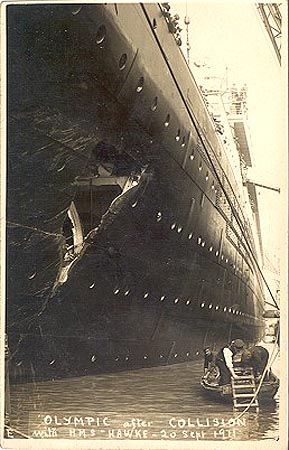
In those days, ships were constructed from the bottom up. The Titanic's keel was double plated giving the ship extra protection incase of a collision.
Over the next two years, the Titanic would slowly be built on the slipway, however she was only an empty shell. Much more work would continue when the Titanic will eventually be launched in 1911.
On October 20th 1910, the Olympic is succesfully launched and is towed to the Dry Dock to begin an extensive fitting out process.

Finally on May 31st 1911, the R.M.S. Titanic's hull is launched into the water. It was this moment where the Titanic claimed it's first victim. A falling support beam collapses and kills a worker instantly, however this wasn't enough to distract the thousands of onlookers watching this massive piece of metal slowly slip down the greased slipway and slide gracefully into the water.

Titanic was towed to the dry dock to begin outfitting. It was during outfitting that Titanic recieved updates which distinguished her from her Sister ship Olympic. These modifications included the forward part of the A Deck Promenade to be enclosed and also the aft B Deck promenade was shortened to accommodate more cabins as this space on the Olympic was reletavely unused. These extra additions made the Titanic heavier than the Olympic making her the largest moving object in the world.
In June 1911, the R.M.S. Olympic embarks on her maiden voyage from Southampton to New York, stopping at Cherbourg in France and Queenstown, now Cobbh, in Ireland.
In September, Titanic's luxurious interiors were well under way with over 100 carpenters carving the Grand Staircase, the woodern pillars and all of the other ornate fittings and fixtures that would make up Titanic's first class areas. However on the 20th of the same month, the R.M.S. Olympic suffers a major accident. She collided with British Royal Navy cruiser H.M.S. Hawke tearing a huge hole in her side, however, both ships still remained afloat. Work on Titanic had to stop so repairs to Olympic could be made, this took 6 weeks, delaying Titanic's Scheduled sailing date by a month. Some said that the new ships were just too big.

In January of 1912, Titanic's 16 woodern lifeboats were fitted along with 4 collapseable boats. This amounted to 20 lifeboats in total, the 16 wooden boats had a capacity for 65 people each and the collapseable boats had room for 40 people each, a total of 1200 spaces, however the Titanic was capeable of carrying up to around 3000 passengers and crew when fully loaded. The laws regarding the number of lifeboats were out of date as ships of this tonnage had never been made before, and it's because of this that the number of lifeboats the Titanic carried actually exceeded the amount required by the law.
The law's in those days didn't aquisition a number of boats due to the amount of passengers carried, but rather to the ship's tonnage and as the Titanic weighed over 46,000 tons and the laws didn't go anywhere near that mark. It was orginially planned to have 64 lifeboats onboard however this was overlooked and people said that amount of boats would worry passengers and make the ship feel unsafe, so it was agreed that 20 lifeboats would be sufficient.
In February, R.M.S. Olympic once again returned to Belfast after losing a Propellar blade, once again delyaing work on the Titanic.
On March 31st, 1912, 3 years after her first keel plate was laid, the R.M.S. Titanic was finished and began only a single day of sea trials before making the journey down to Southampton where she would set sail at 12pm on April 10th...
To Be Continued...

No comments:
Post a Comment